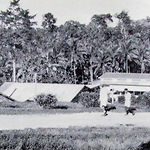Party: Cocoa Industry
Details
The coco or cacao tree (Theobroma cacao) is an evergreen tree in the family Sterculiaceae (alternatively Malvaceae) which grows from four to eight metres tall in tropical regions and is native to the Americas. It requires a humid climate, regular rain and good soil. The tree's beans are used to produce chocolate. The first trees were introduced into the Protectorate in the early 1950s in an attempt to diversify the economy and encourage small crop farming by Solomon Islanders.
Following advice from D. H. Urquart from Cadbury and Sons Ltd. in 1951, the Protectorate Government provided funds to establish trial cocoa plots, the first at Auki on Malaita and the second at Kukum on Guadalcanal. The seeds from the Auki trial were distributed on Malaita to begin local plantations. (BSIP AR 1953-1954) In 1952, R. C. Symes planted cocoa trees at his Holokama plantation on Isabel Island, using seeds from Kerevat Agricultural Station near Rabaul. Kerevat was also the origin of the seeds imported by the government. Planting increased rapidly during the 1950s, and in 1955 Levers Pacific Plantations agreed to participate with the government in a cocoa-growing scheme. (PIM Oct. 1952, Nov. 1955)
A grant from the Commonwealth Development and Welfare Scheme enabled a Cocoa Division to be established within the Department of Agriculture, with the aim of making cocoa the alternative second crop to copra. By the mid-1950s, the extent of European-grown cocoa was reported as forty thousand trees on Rendova and the Shortlands, and thirty-two thousand trees under-planted on coconut plantations in the Russell Islands and Isabel Island. Indigenous-grown cocoa was centred on Malaita, where some forty-two thousand trees were growing by 1956, all under three years old and most supplied by the Auki Agricultural Station. A Cocoa Development section of the Agriculture Department was established in 1958. The first pods of indigenous-grown cocoa were produced on Malaita in 1957, and work began on building a fermentary at Auki, with road extension along the west coast to allow transport of the pods. (AR 1957-1958, 22-23)
The millionth cocoa tree in the Protectorate was planted early in 1961. The second phase of cocoa development was from 1958 to 1965. Local farmers responded well and there were 7,599 acres of new trees planted. The third phase began in 1965, with greater emphasis on good husbandry of existing crops. Cocoa production began in 1959 with 0.4 tons and increased steadily throughout the 1960s: 1960 (7.0 tons), 1961 (12.0 tons), 1962 (21 tons), 1963 (37.3 tons), 1964 (64.1 tons), 1965 (72.0 tons), 1966 (99.5 tons), 1967 (59.8 tons), 1968 (104.9 tons), and 1969 (95.4 tons). Cocoa production was quite variable during the first half of the 1970s: 128.4 tons in 1970; 117.3 tons in 1971; 62.9 tons in 1972; 83.5tons in 1973; and 103.9 tons in 1974. (AR 1974, 41) Cocoa was produced mainly in the Malaita and Western districts, though by 1974 Russell Islands cocoa was coming to bear, which increased the Central District production. (Frazer 1973, 77, 78; NS May 1961; AR 1974, 42)
Processing and transport was always difficult. The cocoa fruit is opened and the pulp and seeds are placed in large containers. The beans are later transferred to wooden crates or baskets separated by banana leaves to enable the best fermentation, which can take two to seven days. Without fermentation there is no chocolate flavour. After fermentation the beans are dried. Sun-drying techniques used elsewhere were unsuited to the rainy Solomons and so platform, hot air and rotary driers were introduced. These added expense and necessitated the development of co-operatives (q.v.). The drying process takes one to two weeks. Transport was always irregular and some co-operatives purchased their own tractors to take crops to ports. Many growers felt that the government had lured them into a new industry with insufficient planning. (Frazer 1973, 77-97)
Related entries
Published resources
Journals
- Pacific Islands Monthly. Details
- British Solomon Islands Protectorate (ed.), British Solomon Islands Protectorate News Sheet (NS), 1955-1975. Details
Reports
- British Solomon Islands Protectorate, British Solomon Islands Protectorate Annual Reports (AR), 1896-1973. Details
- Frazer, Ian L., To' ambaita Report: A Study of Socio-Economic Change in North-Western Malaita, Department of Geography, Victoria University, Wellington, New Zealand, 1973. Details
